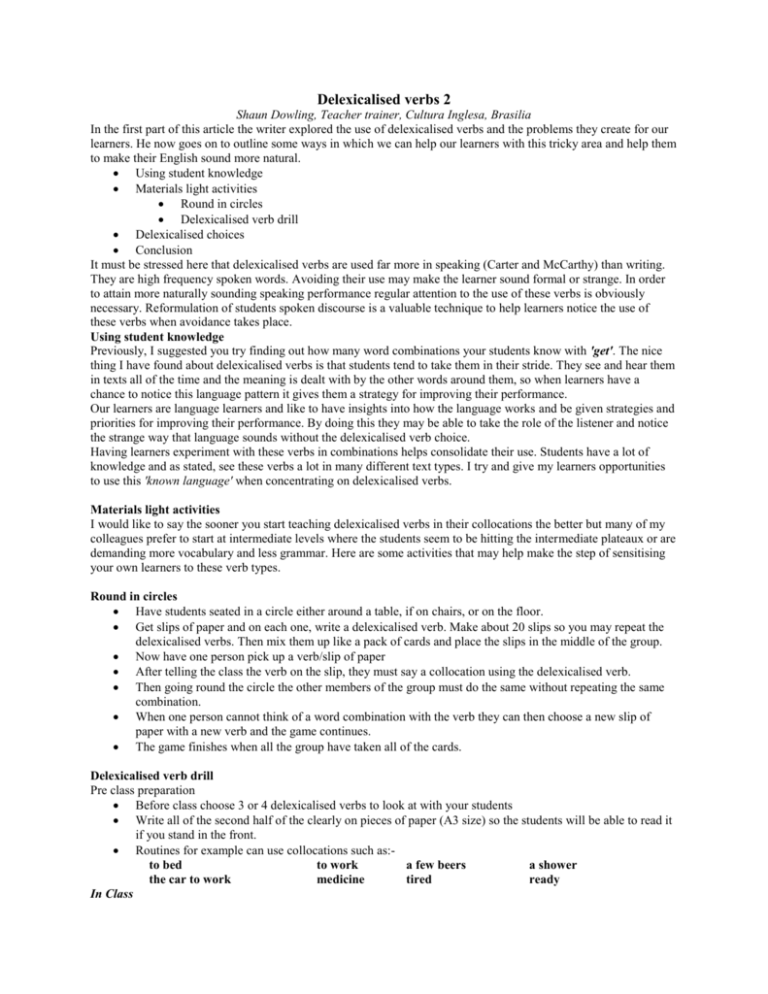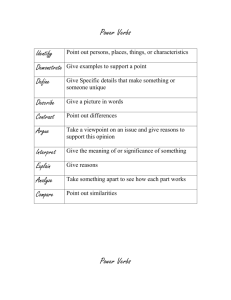Delexicalised verbs 2
advertisement

Delexicalised verbs 2 Shaun Dowling, Teacher trainer, Cultura Inglesa, Brasilia In the first part of this article the writer explored the use of delexicalised verbs and the problems they create for our learners. He now goes on to outline some ways in which we can help our learners with this tricky area and help them to make their English sound more natural. Using student knowledge Materials light activities Round in circles Delexicalised verb drill Delexicalised choices Conclusion It must be stressed here that delexicalised verbs are used far more in speaking (Carter and McCarthy) than writing. They are high frequency spoken words. Avoiding their use may make the learner sound formal or strange. In order to attain more naturally sounding speaking performance regular attention to the use of these verbs is obviously necessary. Reformulation of students spoken discourse is a valuable technique to help learners notice the use of these verbs when avoidance takes place. Using student knowledge Previously, I suggested you try finding out how many word combinations your students know with 'get'. The nice thing I have found about delexicalised verbs is that students tend to take them in their stride. They see and hear them in texts all of the time and the meaning is dealt with by the other words around them, so when learners have a chance to notice this language pattern it gives them a strategy for improving their performance. Our learners are language learners and like to have insights into how the language works and be given strategies and priorities for improving their performance. By doing this they may be able to take the role of the listener and notice the strange way that language sounds without the delexicalised verb choice. Having learners experiment with these verbs in combinations helps consolidate their use. Students have a lot of knowledge and as stated, see these verbs a lot in many different text types. I try and give my learners opportunities to use this 'known language' when concentrating on delexicalised verbs. Materials light activities I would like to say the sooner you start teaching delexicalised verbs in their collocations the better but many of my colleagues prefer to start at intermediate levels where the students seem to be hitting the intermediate plateaux or are demanding more vocabulary and less grammar. Here are some activities that may help make the step of sensitising your own learners to these verb types. Round in circles Have students seated in a circle either around a table, if on chairs, or on the floor. Get slips of paper and on each one, write a delexicalised verb. Make about 20 slips so you may repeat the delexicalised verbs. Then mix them up like a pack of cards and place the slips in the middle of the group. Now have one person pick up a verb/slip of paper After telling the class the verb on the slip, they must say a collocation using the delexicalised verb. Then going round the circle the other members of the group must do the same without repeating the same combination. When one person cannot think of a word combination with the verb they can then choose a new slip of paper with a new verb and the game continues. The game finishes when all the group have taken all of the cards. Delexicalised verb drill Pre class preparation Before class choose 3 or 4 delexicalised verbs to look at with your students Write all of the second half of the clearly on pieces of paper (A3 size) so the students will be able to read it if you stand in the front. Routines for example can use collocations such as:to bed to work a few beers a shower the car to work medicine tired ready In Class Tell the students you are going to teach them 4 words (i.e. go, get, take, have) and write them on the board. When the students have acknowledged this, and maybe found it strange as it is so easy, rub them off the board for them to remember. Now in front of the class have the slips showing and change them around as the students call out the delexicalised verb have them say whole collocation. The delexicalised verb and the word(s) on the slips. Monitor students for correct connected speech pronunciation especially of 'get' and 'make' where the final consonant sound is dropped or the 'go' verb when at times there is assimilation. When they have finished have the learners write as many down as they can remember. I find this practical when introducing new themes to speak about. By trying to keep the language level based on the students current knowledge this allows them to start using rather than avoiding these collocations. Delexicalised choices A good resource for this activity is the Oxford Dictionary of Collocations there is list of some common forms of delexicalised verbs and their collocations. Have students write in their note books the verbs you have chosen. Read out the second part of the collocation and get the learners to write them down under the correct verb After you have given about 30 words, in pairs, students compare lists (sometimes there could be more than one verb to a combination)and see under which verb they have chosen to place the second part of the collocation. As a class check the answers and have students discuss what patterns they have found. Then during every future class, when a new delexicalised verb is found either by your students of yourself the learners can add them to the list first students. Conclusion As my law student had made me realise, delexicalised verbs are probably one of the most important collocations there are. They are used in speaking, they are used to a high degree, they have multiple meanings and should only be understood in their collocations. Also, some students make linguistic choices which allow them to avoid their use which prevents them achieving more naturally sounding speech. Although, he may not have expressed the use of 'get' perfectly, he was not far away from the truth. By using a logical way of looking at one of the most used words in the language. He was making a constant mental effort to use what most learners find easy to avoid and because of this I'm sure , as his teacher, my lack of awareness was more a hindrance than a help. I hope after reading this you won't make the same mistake I did and can take steps to improve your own students performance by being more aware of delexicalised verbs. In the first part of this article the writer explored the use of delexicalised verbs and the problems they create for our learners. Further reading 'Grammar for English Language Teachers', Martin Parrot, CUP 2000 'Exploring Spoken English', Carter and McCarthy CUP 2000 'About Language', Scott Thornbury, CUP 1997 'Introducing Listening', Michael Rost, Penguin 1994 'Implementing the Lexical Approach', Michael Lewis LTP 1994 'Collocations Dictionary', OUP 2001








